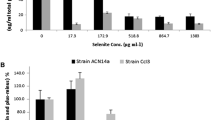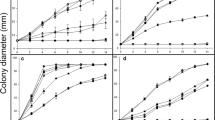Summary
The ability of several filamentous, polymorphic and unicellular fungi to reduce selenite to elemental selenium on solid medium was examined.Fusarium sp. andTrichoderma reeii were the only filamentous fungi, of those tested, which reduced selenite to elemental selenium on Czapek-Dox agar resulting in a red colouration of colonies. Other organisms (Aspergillus niger, Coriolus versicolor, Mucor SK, andRhizopus arrhizus) were able to reduce selenite only on malt extract agar. Several fungi were able to grow in the presence of sodium selenite but were apparently unable to reduce selenite to elemental selenium, indicating that other mechanisms of selenite tolerance were employed, such as reduced uptake and/or biomethylation to less toxic, volatile derivatives. Sodium selenate was more toxic toFusarium sp. than selenite, and the toxicity of both oxyanions was increased in sulphur-free medium, with this effect being more marked for selenate. Scanning electron microscopy ofAspergillus funiculosus andFusarium sp. incubated with sodium selenite showed the presence of needle-like crystals of elemental selenium on the surfaces of hyphae and conidia, while transmission electron microscopy ofA. funiculosus revealed the deposition of electron-dense granules in vacuoles of selenite-treated fungi. Several yeasts were able to grow on MYGP agar containing sodium selenate or sodium selenite at millimolar concentrations. Sone, notablyRhodotorula rubra andCandida lipolytica, and the polymorphic fungusAureobasidium pullulans were also effective at reducing selenite to elemental selenium, resulting in red-coloured colonies.Schizosaccharomyces pombe was able to grow at selenite concentrations up to 5 mmol L−1 without any evidence of reduction, again indicating the operation of other tolerance mechanisms.
Similar content being viewed by others
References
Bennett, W.N. 1988. Assessment of selenium toxicity in algae using turbidostat culture. Water Res. 22: 939–942.
Bock, A., K. Forchhammer, J. Heider, W. Leinfelder, G. Sawers, B. Verprek and F. Zioni. 1991. Selenocysteine: the 21 st amino acid. Mol. Microbiol. 5: 515–520.
Breton, A. and Y. Surdin-Kerjan. 1977. Sulphate uptake inSaccharomyces cerevisiae: biochemical and gnetic study. J. Bacteriol. 132: 224–232.
Brown, T.A. and A. Shrift. 1980. Assimilation of selenate and selenite bySalmonella typhimurium. Can. J. Microbiol. 26: 671–675.
Brown, T.A. and A. Shrift. 1982. Selenium: toxicity and tolerance in higher plants. Biol. Rev. 57: 59–84.
Brown, T.A. and D.G. Smith. 1979. Effects of inorganic selenium compounds on growth, cell size and ultrastructure ofCryptococcus albidus. Microbios Lett. 10: 55–61.
Coch, E.H. and R.C. Greene. 1971. The utilization of selenomethionine byEscherichia coli. Biochim. Biophys. Acta 230: 233–236.
Falcone, G. and W.J. Nickerson. 1963. Reduction of selenite by intact yeast cells and cell free preparations. J. Bacteriol. 85: 754–762.
Gadd, G.M. 1993. Microbial formation and transformation of organometallic and organometalloid compounds. FEMS Microbiol. Rev. 11: 297–316.
Gadd, G.M. 1993. Interactions of fungi with toxic metals. New Phytol. 124: 25–60.
Hudman, J.F. and A.R. Glenn. 1984. Selenite uptake and incorporation bySelenomonas ruminatum. Arch. Microbiol. 140: 252–256.
Kierans, M., A.M. Staines, H. Bennett and G.M. Gadd. 1991. Silver tolerance and accumulation in yeasts. Biol. Metals 4: 100–106.
Kiffney, P. and A. Knight. 1990. The toxicity and bioaccumulation of selenate, selenite and seleno-l-methionine in the cyanobacteriumAnabaena flos-aquae. Arch. Environ. Contam. Toxicol. 19: 488–494.
Lauchli, A. 1993. Selenium in plants: uptake, functions and environmental toxicity. Bot. Acta 106: 455–468.
Lovley, D.R. 1993. Dissimilatory metal reduction. Ann. Rev. Microbiol. 47: 263–290.
Morley, G.F., J.A. Sayer, S.C. Wilkinson, M.M. Gharieb and G.M. Gadd. 1995. Fungal sequestration, mobilization and transformation of metals and metalloids. In: Fungi and Environmental Change (Frankland, J.C., N. Magan and G.M. Gadd, eds), (in press), Cambridge University Press, Cambridge.
Moss, M.O., F. Badii and G. Gibbs. 1987. Reducation of biselenite to elemental selenium byAspergillus parasiticus. Trans. Br. Mycol. Soc. 89: 578–580.
Nickerson, W.J. and G. Falcone. 1963. Enzymatic reduction of selenite. J. Bacteriol. 85: 763–771.
Oremland, R.S., J.T. Hollibaugh, A.S. Maest, T.S. Presser, L.G. Miller and C.W. Culbertson. 1989. Selenate reduction to elemental selenium by anaerobic bacteria in sediments and culture: biogeochemical significance of a novel, sulfate-independent respiration. Appl. Environ. Microbiol. 55: 2333–2343.
Oremland, R.S., N.A. Steinberg, T.S. Presser and L.G. Miller. 1991. In situ bacterial selenate reduction in the agricultural drainage systems of Western Nevada. Appl. Environ. Microbiol. 57: 615–617.
Ramadan, S.A., A.A. Razak, Y.A. Yousseff and N.M. Sedky. 1988. Selenium metabolism in a strain ofFusarium. Biol. Trace Element Res. 18: 161–170.
Stadtman, T.C. 1990. Selenium biochemistry. Annu. Rev. Biochem. 59: 111–127.
Steinberg, N.A. and R.S. Oremland. 1990. Dissimilatory selenate reduction potentials in a diversity of sediment types. Appl. Environ. Microbiol. 56: 3550–3557.
Thompson-Eagle, E.T. and W.T. Frankenberger. 1992. Bioremediation of soils contaminated with selenium. Adv. Soil Sci. 17: 262–310.
Thompson-Eagle, E.T., W.T. Frankenberger and K.E. Longley. 1991. Removal of selenium from agricultural drainage water through soil transformation. In: The Economics and Management of Water and Drainage in Agriculture (Dinar, A. and D. Zilberman, eds), pp. 169–186, Kluwer Academic Publishers, Norwell, MA.
Tweedie, J.W. and I.H. Segal. 1970. Specificity of transport processes for sulfur, selenium and molybdenum anions by filamentous fungi. Biochim. Biophys. Acta 196: 95–106.
Weiss, K.F., C. Ayres and A.A. Kraft. 1965. Inhibitory action of selenite onEscherichia coli, Proteus vulgaris andSalmonella thompson. J. Bacteriol. 90: 857–862.
Weissman, G.S. and S.F. Trelease. 1955. Influence of sulfur on the toxicity of selenium toAspergillus. Am. J. Bot. 42: 489–495.
Wheeler, A., R. Zingaro, K. Irgolic and N. Bottino. 1982. The effect of selenate, selenite and sulphate on the growth of six unicellular marine algae. J. Exp. Mar. Biol. Ecol. 57: 181–194.
White, C. and G.M. Gadd. 1995. Reduction of metal cations and oxyanions by anaerobic and metal-resistant microorganisms: chemistry, physiology and potential for the control and bioremediation of toxic metal pollution. In: Extremophiles: Microbial Life in Extreme Environments (Hoshikori, K. and W.G. Grant, eds), (in press), Wiley, New York.
Zieve, R., P.J. Ansell, T.W.K. Young and P.J. Peterson. 1985. Selenium volatilization byMortierella species. Trans. Br. Mycol. Soc. 84: 177–179.
Author information
Authors and Affiliations
Rights and permissions
About this article
Cite this article
Gharieb, M.M., Wilkinson, S.C. & Gadd, G.M. Reduction of selenium oxyanions by unicellular, polymorphic and filamentous fungi: Cellular location of reduced selenium and implications for tolerance. Journal of Industrial Microbiology 14, 300–311 (1995). https://doi.org/10.1007/BF01569943
Received:
Accepted:
Issue Date:
DOI: https://doi.org/10.1007/BF01569943




